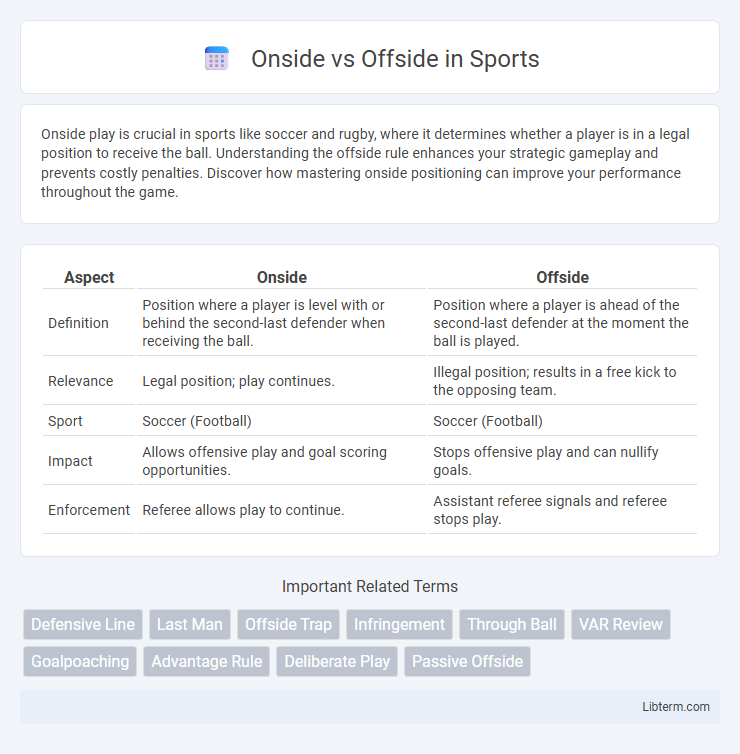Onside play is crucial in sports like soccer and rugby, where it determines whether a player is in a legal position to receive the ball. Understanding the offside rule enhances your strategic gameplay and prevents costly penalties. Discover how mastering onside positioning can improve your performance throughout the game.
Table of Comparison
| Aspect | Onside | Offside |
|---|---|---|
| Definition | Position where a player is level with or behind the second-last defender when receiving the ball. | Position where a player is ahead of the second-last defender at the moment the ball is played. |
| Relevance | Legal position; play continues. | Illegal position; results in a free kick to the opposing team. |
| Sport | Soccer (Football) | Soccer (Football) |
| Impact | Allows offensive play and goal scoring opportunities. | Stops offensive play and can nullify goals. |
| Enforcement | Referee allows play to continue. | Assistant referee signals and referee stops play. |
Understanding Onside and Offside: Key Definitions
Onside and offside are crucial terms in sports such as soccer and rugby, defining player positioning relative to the ball and opposing team at the moment of play. Being onside means a player is legally positioned behind or level with the ball or last defender, allowing active participation in the game. Offside occurs when a player is ahead of the ball or last opponent in forbidden zones, resulting in penalties or stoppages to ensure fair play and strategic game flow.
The Origins of Onside and Offside Rules
The origins of onside and offside rules date back to early forms of football in 19th-century England, where they were established to maintain fair play and strategic positioning. Onside rules ensured attacking players stayed behind the ball, while offside rules prevented unfair advantages by limiting forward positioning before the ball was played. These foundational regulations evolved through organizations like the Football Association, shaping modern soccer's gameplay and maintaining balance between offense and defense.
How Offside Works in Football
Offside in football occurs when an attacking player is positioned nearer to the opponent's goal line than both the ball and the second-last defender at the moment the ball is played to them. The offside rule aims to prevent unfair advantages by restricting players from gaining a positional edge during attacks. Referees and assistant referees enforce this rule by closely monitoring player positions and play timing to ensure fair competition.
The Role of the Referee in Offside Decisions
The referee plays a crucial role in offside decisions by collaborating closely with assistant referees, who monitor player positions relative to the second-last defender at the moment the ball is played. Instantaneous judgment and clear communication ensure the correct enforcement of offside rules, preventing unfair advantages and maintaining the fairness of the game. Technology such as VAR supports referees by providing video replays to review and confirm offside calls accurately during critical match moments.
Common Misconceptions About Onside and Offside
Many soccer fans mistakenly believe that an attacker must be completely behind the last defender to avoid being offside, whereas the rules state that any part of the attacker's body in line with or behind the second-to-last defender is onside. Another common misconception is that being in an offside position automatically results in an offside offense; the player must be actively involved in play for an offense to be called. Additionally, some confuse onside kick rules in American football with soccer offside rules, though onside kicks pertain exclusively to kickoff strategies and do not involve position relative to defenders.
Onside Strategies: Gaining the Advantage
Onside strategies focus on maximizing offensive opportunities by positioning players ahead of the ball, creating dynamic attacking plays and disrupting defensive lines. Maintaining onside positioning involves precise timing and spatial awareness to exploit gaps and receive passes legally, enhancing team coordination and ball control. Effective onside tactics increase scoring chances and pressure the opposition, leveraging field positioning for competitive advantage.
Offside Traps: Defensive Tactics Explained
Offside traps are strategic defensive tactics used in soccer to catch attacking players offside by stepping forward at the right moment, disrupting the opponent's offensive play and forcing turnovers. Successful execution relies on coordinated timing among defenders and precise communication to maintain a high defensive line without leaving gaps exploitable by attackers. Teams employing offside traps reduce scoring opportunities by manipulating the offside rule, increasing defensive pressure and controlling the pace of the game effectively.
VAR Technology and Offside Calls
VAR technology has revolutionized the accuracy of offside calls in football by providing real-time video review and precise offside line drawing, significantly reducing human error. High-definition cameras and multiple angles enable referees to assess whether an attacker is beyond the second-last defender at the moment the ball is played, ensuring fair play and minimizing controversial decisions. The integration of VAR in offside decisions has led to more consistent enforcement of the offside rule, enhancing the integrity of the game.
Famous Onside and Offside Moments in Sports History
The 1999 UEFA Champions League Final featured a legendary offside moment when Manchester United's Teddy Sheringham scored in injury time, turning the match around. One of the most iconic onside plays occurred in the 1980 "Miracle on Ice," as the U.S. hockey team executed a perfect onside puck play to secure their unexpected victory over the Soviet Union. These moments define how critical precise offside and onside calls are in shaping sports history and thrilling fans worldwide.
The Impact of Onside and Offside on Modern Football
The impact of onside and offside rules in modern football significantly shapes team strategies and game dynamics, influencing player positioning and attacking opportunities. Offside regulations prevent unfair advantages, maintaining competitive balance, while onside plays encourage quick thinking and precise timing to exploit defensive gaps. These rules enhance the pace and tactical complexity of football, promoting skillful play and strategic depth.
Onside Infographic

 libterm.com
libterm.com